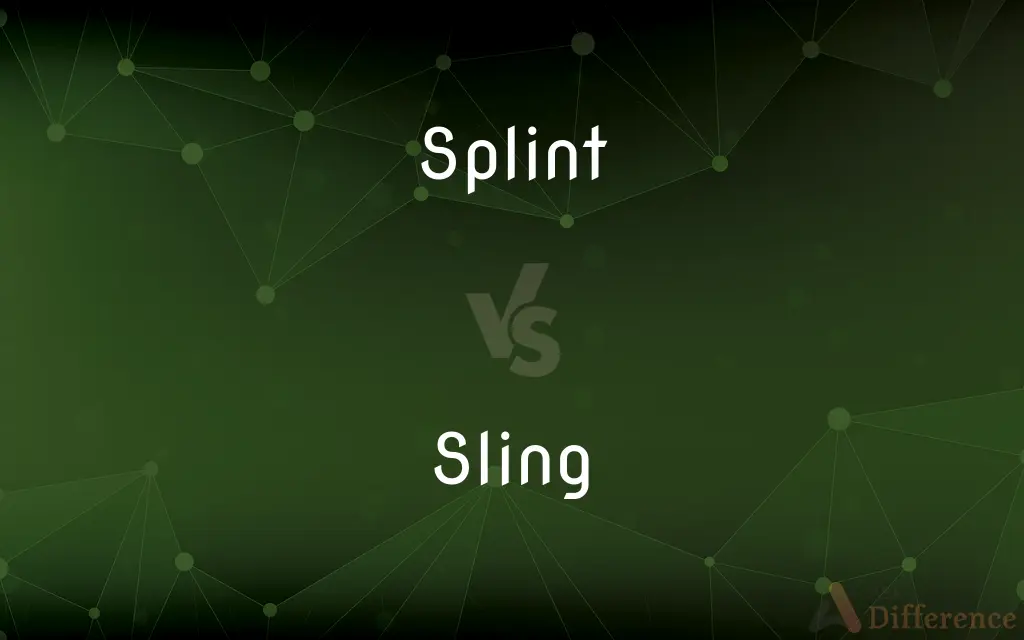Splint vs. Sling — What's the Difference?
By Maham Liaqat & Fiza Rafique — Updated on March 17, 2024
Splints support and immobilize a body part with an injury, while slings are used to elevate and rest an injured arm or shoulder.

Difference Between Splint and Sling
Table of Contents
ADVERTISEMENT
Key Differences
Splints are medical devices designed to support and immobilize a body part, such as a broken bone or sprained joint, to prevent further injury and facilitate healing. They can be rigid or flexible and are often used temporarily until a permanent cast can be applied. On the other hand, slings are used to support and elevate an injured arm or shoulder, reducing pain and swelling by keeping the arm across the body or against the chest.
While splints are applied directly to the injured area to restrict movement and provide stability, slings are worn around the neck and used to cradle the arm, without directly immobilizing the injury site. This difference in application means that splints are more about immobilization, whereas slings are about elevation and rest.
Splints can be made from a variety of materials, including metal, plastic, or padded rigid materials, and are adjustable to fit different parts of the body. Conversely, slings are typically made from soft materials like cloth and are designed to provide comfortable support without exerting pressure on the injury.
The use of a splint is usually recommended for injuries that need immobilization to heal properly, such as fractures or severe sprains. Slings, however, are often used for injuries where elevation is beneficial, such as minor fractures, dislocations, or post-surgical recovery, allowing the injured arm or shoulder to rest comfortably.
While splints provide firm support to stabilize an injury, they require careful application to ensure they do not impede circulation or cause further damage. Slings, being less restrictive, are easier to use but must be adjusted correctly to provide the necessary support without causing neck or back strain.
ADVERTISEMENT
Comparison Chart
Purpose
Support and immobilize an injured body part
Elevate and rest an injured arm or shoulder
Application
Directly to the injured area
Around the neck, supporting the arm
Immobilization
High, restricts movement
Lower, allows for some movement
Material
Metal, plastic, padded materials
Soft materials like cloth
Recommended Use
Fractures, severe sprains
Minor fractures, dislocations, post-surgery
Compare with Definitions
Splint
A device to immobilize and support injured limbs.
The doctor applied a splint to stabilize the broken wrist.
Sling
A support for elevating injured arms or shoulders.
After the shoulder surgery, a sling was provided for support and elevation.
Splint
Often used temporarily before casting.
A temporary splint was placed until the swelling decreased for a permanent cast.
Sling
Helps in reducing pain and swelling.
The sling helped significantly in reducing the swelling by keeping the arm elevated.
Splint
Made from a variety of rigid or semi-rigid materials.
A plastic splint was used for its lightweight and durable properties.
Sling
Less restrictive, allowing for some movement.
The sling allowed for slight movements, aiding in the recovery process.
Splint
Can be adjustable for different body parts.
Adjustable splints are used to fit varying sizes of limbs securely.
Sling
Worn around the neck to cradle the arm.
The patient wore the sling around his neck to keep the arm elevated.
Splint
Requires careful application to avoid complications.
The splint was applied with caution to not impede blood circulation.
Sling
Made from soft, comfortable materials.
A soft cloth sling was chosen for comfort during the recovery period.
Splint
A strip of rigid material used for supporting and immobilizing a broken bone when it has been set
She had to wear splints on her legs
Sling
A flexible strap or belt used in the form of a loop to support or raise a hanging weight
The horse had to be supported by a sling fixed to the roof
Splint
A long, thin strip of wood used to light a fire.
Sling
A simple weapon in the form of a strap or loop, used to hurl stones or other small missiles
700 men armed only with slings
Splint
A bony enlargement on the inside of a horse's leg, on the splint bone.
Sling
A bribe or gratuity.
Splint
A fragment of diamond.
Sling
A sweetened drink of spirits, especially gin, and water.
Splint
Secure (a broken limb) with a splint or splints
His leg was splinted
Sling
Suspend or arrange (something), especially with a strap or straps, so that it hangs loosely in a particular position
A hammock was slung between two trees
Splint
A thin piece split off from a larger piece; a splinter.
Sling
Casually throw or fling
Sling a few things into your knapsack
Splint
A rigid device used to prevent motion of a joint or of the ends of a fractured bone.
Sling
Pay a bribe or gratuity
They didn't forget to sling when the backhanders came in
Splint
A dental appliance put on the teeth to protect them from grinding or from moving out of place.
Sling
A weapon consisting of a looped strap in which a stone is whirled and then let fly.
Splint
A thin, flexible wooden strip, such as one used in the making of baskets or chair bottoms.
Sling
A slingshot.
Splint
A plate or strip of metal.
Sling
A band suspended from the neck to support an injured arm or hand.
Splint
A bony enlargement of the cannon bone or splint bone of a horse.
Sling
A length of fabric worn on the body for carrying an infant.
Splint
To support or restrict with or as if with a splint.
Sling
A strap of a shoe that fits over the heel.
Splint
A narrow strip of wood split or peeled from a larger piece.
Sling
A strap used to carry a rifle over the shoulder.
Splint
(dentistry) A dental device applied consequent to undergoing orthodontia.
Sling
(Nautical) A rope or chain that attaches to the mast and supports a yard.
Splint
(medicine) A device to immobilize a body part.
Sling
The act of hurling something.
Splint
A segment of armour consisting of a narrow overlapping plate.
Sling
A drink consisting of brandy, whiskey, or gin, sweetened and usually lemon-flavored.
Splint
(mining) splent coal
Sling
To hurl with a sling
Sling stones.
Splint
(zootomy) A bone found on either side of a horse's cannon bone; the second or fourth metacarpal (forelimb) or metatarsal (hindlimb) bone.
Sling
To throw or fling
"He ripped out the fish guts and slung them to the gulls" (Donna Morrissey).
Splint
A disease affecting the splint bones, as a callosity or hard excrescence.
Sling
To move by means of a sling; raise or lower in a sling
Sling cargo into a hold.
Splint
(transitive) To apply a splint to; to fasten with splints.
Sling
To place in a hanging or supported position
Sling a towel over one's shoulder.
Splint
To support one's abdomen with hands or a pillow before attempting to cough.
Sling
To throw with a circular or arcing motion.
Splint
To split into thin, slender pieces; to splinter.
Sling
To throw with a sling.
Splint
A piece split off; a splinter.
Sling
(nautical) To pass a rope around (a cask, gun, etc.) preparatory to attaching a hoisting or lowering tackle.
Splint
A thin piece of wood, or other substance, used to keep in place, or protect, an injured part, especially a broken bone when set.
Sling
(weapon) An instrument for throwing stones or other missiles, consisting of a short strap with two strings fastened to its ends, or with a string fastened to one end and a light stick to the other.
Splint
A splint bone.
Sling
A kind of hanging bandage put around the neck, in which a wounded arm or hand is supported.
Splint
A disease affecting the splint bones, as a callosity or hard excrescence.
Sling
A loop of cloth, worn around the neck, for supporting a baby or other such load.
Splint
One of the small plates of metal used in making splint armor. See Splint armor, below.
The knees and feet were defended by splints, or thin plates of steel.
Sling
A loop of rope, or a rope or chain with hooks, for suspending a barrel, bale, or other heavy object, in hoisting or lowering.
Splint
Splint, or splent, coal. See Splent coal, under Splent.
Sling
A strap attached to a firearm, for suspending it from the shoulder.
Splint
To split into splints, or thin, slender pieces; to splinter; to shiver.
Sling
A band of rope or iron for securing a yard to a mast.
Splint
A thin sliver of wood;
He lit the fire with a burning splint
Sling
The act or motion of hurling as with a sling; a throw; figuratively, a stroke.
Splint
An orthopedic mechanical device used to immobilize and protect a part of the body (as a broken leg)
Sling
(climbing) A loop of rope or fabric tape used for various purposes: e.g. as part of a runner, or providing extra protection when abseiling or belaying.
Splint
Support with a splint;
Splint a broken finger
Sling
A drink composed of a spirit (usually gin) and water sweetened.
Gin sling
A Singapore sling
Sling
A young or infant spider, such as one raised in captivity.
Sling
An instrument for throwing stones or other missiles, consisting of a short strap with two strings fastened to its ends, or with a string fastened to one end and a light stick to the other. The missile being lodged in a hole in the strap, the ends of the string are taken in the hand, and the whole whirled rapidly round until, by loosing one end, the missile is let fly with centrifugal force.
Sling
The act or motion of hurling as with a sling; a throw; figuratively, a stroke.
The slings and arrows of outrageous fortune.
At one slingOf thy victorius arm, well-pleasing Son.
Sling
A contrivance for sustaining anything by suspension
Sling
A drink composed of spirit (usually gin) and water sweetened.
Sling
To throw with a sling.
Sling
To throw; to hurl; to cast.
Sling
To hang so as to swing; as, to sling a pack.
Sling
To pass a rope round, as a cask, gun, etc., preparatory to attaching a hoisting or lowering tackle.
Sling
A highball with liquor and water with sugar and lemon or lime juice
Sling
A plaything consisting of a Y-shaped stick with elastic between the arms; used to propel small stones
Sling
A shoe that has a strap that wraps around the heel
Sling
A simple weapon consisting of a looped strap in which a projectile is whirled and then released
Sling
Bandage to support an injured forearm; consisting of a wide triangular piece of cloth hanging from around the neck
Sling
Hurl as if with a sling
Common Curiosities
How do you know if a splint is too tight?
If a splint is too tight, it may cause increased pain, numbness, or swelling, indicating it needs adjustment.
What is the main purpose of a splint?
A splint supports and immobilizes an injured body part to prevent further injury and aid in healing.
How does a sling help in recovery?
A sling supports and elevates an injured arm or shoulder, reducing pain and swelling, and promoting healing.
Can splints be used for all types of injuries?
Splints are mainly used for injuries that require immobilization, such as fractures or severe sprains.
Is it okay to wear a sling for a long period?
Slings should be worn as advised by a healthcare provider, as prolonged use without medical guidance can affect recovery.
Are splints and slings only used for broken bones?
Splints and slings can be used for a variety of injuries, including fractures, dislocations, sprains, and post-surgical recovery.
Should I remove my sling at night?
Follow your healthcare provider's advice, as in some cases, it may be recommended to wear the sling even while sleeping.
Can I use a splint for a sprained ankle?
Yes, splints can be used for sprained ankles to provide support and immobilize the joint for healing.
What materials are slings made from?
Slings are typically made from soft materials, like cloth, to provide comfortable support.
Can I adjust my sling by myself?
Yes, slings can be adjusted for comfort, but it's important to follow medical advice to ensure proper support.
What are the signs of improper splint application?
Improper splint application can lead to increased pain, restricted circulation, or worsening of the injury.
How long should a splint be worn?
The duration depends on the injury's severity and the healing process, as advised by a healthcare provider.
Can slings cause any discomfort?
If not adjusted properly, slings can cause discomfort, neck, or back strain due to the uneven distribution of weight.
How is a sling adjusted for optimal support?
A sling should be adjusted so that the arm or shoulder is comfortably elevated, without causing strain to the neck or back.
Can a splint be reused for different injuries?
Depending on the type and material, some splints can be reused or adjusted for different injuries, but cleanliness and fit should always be considered.
Share Your Discovery

Previous Comparison
Brass vs. Chrome
Next Comparison
Sitar vs. VeenaAuthor Spotlight
Written by
Maham LiaqatCo-written by
Fiza RafiqueFiza Rafique is a skilled content writer at AskDifference.com, where she meticulously refines and enhances written pieces. Drawing from her vast editorial expertise, Fiza ensures clarity, accuracy, and precision in every article. Passionate about language, she continually seeks to elevate the quality of content for readers worldwide.














































